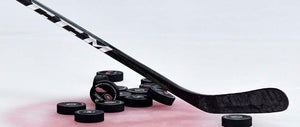How to Choose a Hockey Stick
Mar 15, 2021
Choosing the right hockey stick can be a very daunting if you are new to hockey. There's a handful of brands, many blade patterns, flex, and finishes. We walk you through everything you need to consider.

Image: Cole Burston/Bloomberg
Key Considerations
- Which way you shoot (left or right)
- Flex
- Pattern
- Brand
- Shaft finish
- Shaft shape
- Budget
Finally, I'll tell you how I select my sticks.
Lefty or Righty?
If you're completely new to hockey, the first thing you need to do is pick up a broom. If you picked it up and sweep with your left hand on the bottom, you likely shoot left for hockey. If your right hand is at the bottom, you're likely a right shooter for hockey.
While most of us are right handed when writing, it doesn't mean we feel more comfortable playing hockey right handed. If you write with your right hand, you likely have more dexterity in your right hand, making you a more suitable left-handed hockey player. This is because lefties in hockey (left hand in the middle of the stick) use their right hand (holding top of the stick) for better control when stickhandling.
Ultimately, this is completely a personal decision. Choose left or right, whichever you feel more comfortable with.
My Pick: Completely irrelevant to you, but I'm a lefty.
Hockey Stick Flex - What's Right For Me?
The flex of a stick is how many pounds of pressure required to bend the stick shaft by 1 inch. Flex on a stick can provide extra whip when shooting, giving your shot extra zip. However, too much flex may cause the stick to feel too whippy and make it difficult to take slap shots, receive passes or battle for pucks.
The general rule of thumb is you want to use a flex that is half your weight. If you weight 170lb, an 85 flex may be a good starting point for you. Once you have used that stick, you can experiment by getting a stick with more flex (75), or less flex (95) to narrow down your preference. Generally, if you prefer wrist shots and snap shots, you will want more flex (or lower flex rating), and a less flex (higher flex rating) for slap shots.
Many NHL players use a flex rating of less than 1/2 of their weight to maximize the amount of velocity a stick can provide when shooting.
My Pick: 70-75 flex.
What's The Best Hockey Blade Pattern?
The hockey blade comes in many different configurations, these configurations are called "patterns", each pattern will have their own characteristics, curving at a different point and opening up at a different point, some patterns may include special characteristics such as different blade length or toe shapes.
To make it more confusing, manufacturers often change the names of the patterns over time based on the NHL stars they endorse, and pattern names may be different across different brands. Three of the most popular patterns are P88, P92, and P28. These names are designated by Bauer, and are also commonly referred to as Kane(P88), Sakic(P92), and Giroux(P28). Many other patterns are derivatives of these blades, simply changing the curve to be more heel or toe oriented (curve may open up at various points of the blade).
P88 - Very simple blade with a mid-curve (curve of the blade occurs in the middle of the blade), and no opening (does not curve up). Great for stick handling and keeping the puck from flopping. Excellent for backhand shots. More difficult to lift puck over goalies in tight when close to the crease.
P92 - Another mid-curve blade, opens up mid way, great for shooting high and builds confidence for beginners who struggle to lift pucks with P88. More difficult to execute backhands due to the more open curve (more closed for backhands).
P28 - Least friendly pattern for beginners because the blade is designed for snap shots, which is usually more difficult for beginners to master. This blade has 2 profiles which changes the lie (angle where shaft meets the blade) depending on which part of the blade is touching the ice. It's an open curve style blade, fantastic at cupping the puck when stickhandling, but may cause pucks to flutter when passing or shooting if used incorrectly.
I really like the P92 for beginners because it is such a confidence builder to be able to snipe that puck top shelf easily, but the P88 is also a great pattern for beginners because of it's versatility. Both patterns can easily be found at retail stores, unlike some of the other less popular patterns.
My Pick: P92 for beginners, P28 for intermediate players.
When shopping for a stick, you'll notice every brand has a different name for their patterns. See table below to find curves that are similar to each one across various brands.

Source: https://hockeyrepairshop.com/pages/blade-pattern-charts#P28bauer
What's The Best Hockey Stick Brand For Me?
There are many ways to measure what's best: number of NHL players using this brand; number of models it has; number of sticks sold etc. At the end of the day though, it comes down to personal preference.
You'll be able to find several big brands at any hockey store, including Bauer, CCM, Warrior, True, STX, and Sherwood. In recent years, some newer brands have arrived on the scene, offering their own innovations and customizable options, including NoName, Verbero, Colt, Mode, and Elevate.
Each brand has a variety of product lines tailored to specific players. In order to compare sticks, we need to understand each product line and what they stand for, then compare sticks at similar price points within those product lines. Comparing a top of the line Bauer with an entry level CCM would not yield some obvious results, similar to when we compare a Ferrari with an economy car.
Hockey Stick Product Lines (As of March, 2021)
Hockey companies offer sub-brands to identify various product tailored for a specific need. If you believe in the marketing hype, each sub-brand offers different technologies to deliver on their solution.
Bauer sub-brands:
- Vapor - designed for quick releases with low kickpoint
- Supreme - designed for powerful shots with high kickpoint
- Nexus - designed for effortless shots with mid kickpoint
CCM sub-brands:
- Ribcore - offering agility using a low kickpoint
- Jetspeed - offering speed using a hybrid kickpoint
- SuperTacks - offering power using a mid kickpoint
Warrior sub-brands:
- Alpha - low kick response with a stable powerful release.
- Covert - magnifies power and quick release.
True sub-brands:
- A-Series - designed for strength, balance, and quick release
- X-Series - designed for accuracy, control, and feel
STX sub-brands:
- Surgeon - features puregrip shaft for increased control and dual-flex with mid and low kickpoint for fast release
- Stallion - features a constant flex throughout the shaft for maximum energy transfer when shooting
Verbero sub-brands:
- Mercury - light weight and durable design
NoName sub-brands:
- None. NoName has 1 model only, pro stock quality at no name prices. No expensive endorsements and pro agreements means lower prices for you
Colt sub-brands
- Colt4 - coated with innovative materials to increase durability
- ColtPro - not coated for durability, classic feel
Elevate sub-brands
- XL27 - featuring a bent shaft for improved performance
Within each sub-brand, manufacturers offer various models to provide a tailored solution for various price points. E.g., Flylite has the most technology and is most expensive, followed by 2X Pro, 2X, 2X Team, 2X SE, and lastly X2.7.
My Pick: Bauer Vapor, because it uses a stick shaft technology borrowed from a defunct and beloved hockey company called Easton. Their Elliptical shafts were legendary!
Hockey Stick Finishes
Hockey sticks generally come in 2 finishes, glossy/matte or grip. Glossy and matte finishes are smooth finishes on the stick shaft, which allows you to slide your hand and glove along very easily. Grip finishes have a rubbery feel to the shaft to reduce your ability to slide your glove along the shaft. Each has advantages when stickhandling and is purely a personal preference. Some newer models have introduced hybrid grips, offering grip finish in certain aeras of the shaft, while keeping the remaining parts glossy or matt.
My Pick: Grip finish.
Hockey Stick Shaft Shape
Stick shafts typically come in 2 finishes, round or square. In my experience, square shafts provide a bit more control when shooting, while round shafts may be preferred by those with slightly smaller hands. This one really does come down to personal preference.
Some companies will also offer a textured finish like ribs and bumps on the shafts to provide more grip.
My Pick: Square shaft.
How Much To Spend On a Hockey Stick
Unlike other industries where companies charge much more for product that are the same as their affordable counter parts (e.g., luxury hand bags), hockey sticks are priced according to their technology. More expensive sticks are lighter, and have dampening technologies that help reduce vibration in the blade. Most players prefer lighter sticks with great dampening, because they offer better maneuverability when battling for pucks and better puck feel.
How much you value these technologies is completely up to you. If you're a beginner, you likely won't benefit from using a top-of-the-line stick. It likely won't feel much different to you than a mid-end stick aside from being a few grams lighter.
A lower to mid priced option is likely to be sufficient if you are just starting out. While lower end sticks may be heavier than their performance counter parts, they are great for beginners testing different flexes and patterns. Once you have found the pattern or flex you love, you can get a mid or higher end option while relegating your first sticks as back up or training sticks.
My Pick: Sticks in the mid-high performance range offers best combination of technology and value.
How I Chose My Sticks
I believe all of the major hockey brands produce great products, and have had positive (and negative) experiences with each. Since new models are released every year, it's difficult to say whether you'd like the newer model over the previous one. I value getting a tool with the right specifications for my play style and budget first and foremost.
Here's my journey: go straight to the clearance section to find last year's sticks at a discount. I then look for my shot (left), favourite curve (P28), and flex (70-75). At this point, I narrow the sticks down to the top of the line models with best technology (lightest, and generally better puck feel), then choose one based on the finish (square shaft, grip finish). I pay little attention to product lines because I am only an intermediate player who care rarely tell the difference.
Lastly
The stick is only one of your tools. Just like any tool, it's ability to do the job is in the user's hands. Sure, buying the same top-of-the-line stick that your favourite NHL player uses may feel great, but it's probably overkill for most beginners. If you can afford it, great! If not, no sweat, know that your performance isn't compromised greatly because of your stick. Focus on technique and training. Have fun and enjoy your time on the ice!
If you've made it all the way here, thanks for reading! Good luck, and welcome to the wonderful game of hockey!



